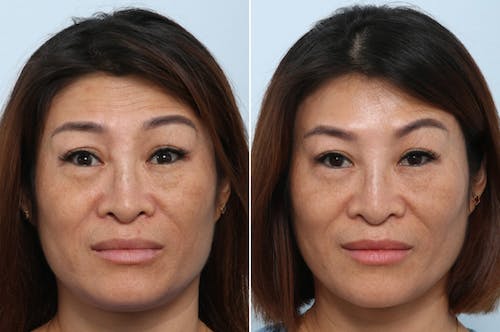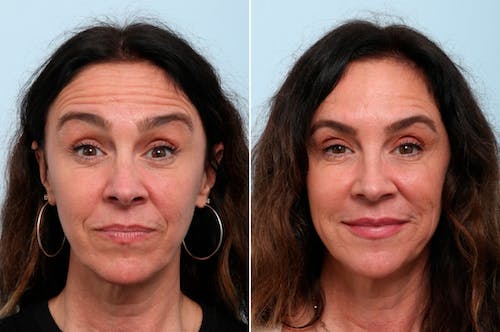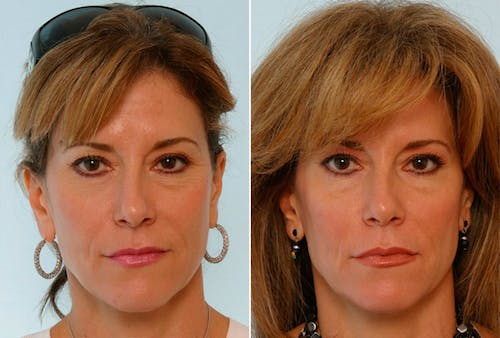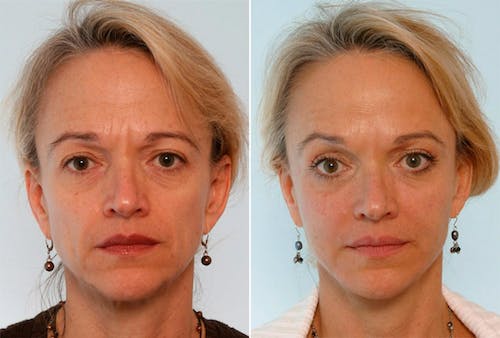35+ Years of Experience
3k+ Real Patient Reviews
10,000+ Surgeries Performed
Texas Super Doctor
BOTOX in Houston
BOTOX is a non-invasive injectable treatment designed to swiftly and effectively alleviate early signs of facial aging. By temporarily relaxing facial muscles responsible for expression lines, it offers a rapid solution for these common concerns, providing a more youthful appearance without the need for surgery.

BOTOX Before & After Photos
Discover why people across the U.S. and internationally select our clinic as their favored destination for non-surgical treatments in Houston.
What is Botox Cosmetic?
Botox Cosmetic is an injectable treatment made from a purified form of botulinum toxin that is used to temporarily relax facial muscles and smooth facial wrinkles and lines. It works by blocking nerve signals to the targeted muscles, which temporarily prevents them from contracting. This allows the overlying skin to appear smooth and wrinkle-free. Botox is commonly used to treat frown lines, forehead creases, and crow’s feet. It can also lift the corners of the mouth, soften bands in the neck, and minimize a gummy smile. Botox treatment provides a non-surgical solution to smooth signs of aging for a more youthful appearance.

Advantages of Botox
Botox offers several benefits to individuals who are bothered by signs of the natural aging process. If you are seeking a more youthful appearance in Houston, TX. Here are some key advantages of Botox Cosmetic treatment:
- Non-surgical and Minimally Invasive: Botox Cosmetic is a non-surgical procedure that only involves injections. This eliminates the risks and recovery time associated with surgical procedures.
- Quick and Convenient: Botox treatments are quick, often taking less than 30 minutes. This makes it an ideal treatment option for individuals with busy daily routines
- Immediate Visible Results: Results can be seen within a few days after treatment, with full effects visible within two weeks.
- Temporary and Reversible: The effects of Botox are temporary and usually last three to four months. This allows patients to try the treatment without any long-term commitment.
- Customizable: Botox treatments can be tailored to meet the unique needs of each patient. The amount and location of the injections can be adjusted to achieve the desired result.
- Preventive Treatment: Botox can be used as a preventive measure in younger patients to stop the future formation of wrinkles.
Ideal Candidates for Botox Cosmetic in Houston, TX
- Individuals aged between 18 and 65
- Those looking to treat dynamic wrinkles such as crow's feet, forehead lines, and frown lines
- Individuals with no allergies to any ingredients in Botox
- Those not pregnant or breastfeeding
- Individuals without any neurological conditions
- Those without any active skin infection at the injection site
It’s important to consult with a qualified medical professional like Dr. Vitenas to determine if you’re a good candidate.

Botox Cosmetic Procedure in Houston
Initial consultation:
During the initial consultation, Dr. Vitenas will assess your facial anatomy, skin type, and the severity of your wrinkles. This will help him create a personalized treatment plan that suits your unique needs.
Preparing the Injection Sites:
The treatment areas will be cleaned, and a topical anesthetic may be applied to numb the area and ensure your comfort during the procedure.
Administering the Injections:
Dr. Vitenas uses the finest needles to inject Botox Cosmetic into the targeted facial muscles. The number of injections will depend on the severity of your wrinkles and your desired results.
Post-Treatment Care:
After the injections, you may be advised to use ice packs to help reduce minor bruising or swelling at the injection site. You’ll also be advised to avoid strenuous activities for a few hours after the procedure.
Botox Cosmetic Recovery
The recovery process after a Botox Cosmetic procedure is typically quick and uneventful. Immediately after the procedure, you might notice some minor bruising or redness at the injection sites. These side effects are temporary and should subside within a few hours.
Most patients can return to their normal activities immediately after the treatment. However, it’s important to avoid rubbing or massaging the treated areas to prevent the Botox from spreading to other areas.
Remember, every individual’s recovery process is unique. Always follow the post-treatment care instructions provided by Dr. Vitenas to ensure a smooth recovery and optimal results.
Botox Cosmetic
Results
COST OF BOTOX IN HOUSTON, TX
At Vitenas Cosmetic Surgery, our approach to pricing Xeomin and Botox treatments is based on a per-unit system to closely match your desired outcomes. We charge $14.00 per unit for Xeomin, with Botox Cosmetic being slightly higher in price. The total cost of your treatment, which depends on the amount needed and the specific areas to be treated, will be determined during your consultation with Dr. Vitenas.
Typically, the cost for these treatments falls between $350 and $700. This price range reflects the versatility of Xeomin and Botox in achieving various aesthetic goals, making it difficult to offer a precise quote before a consultation. During your consultation with Dr. Vitenas, he will assess your needs to provide you with a detailed treatment plan and an accurate cost estimate tailored to your unique requirements.
Schedule a Free Consultation with Dr. Vitenas
If you’re considering Botox Cosmetic in Houston, TX, we invite you to schedule a consultation with Dr. Vitenas. With over 35 years of experience in cosmetic surgery, Dr. Vitenas is an expert injector dedicated to personalized patient care. He will work closely with you to understand your aesthetic goals. Contact us today at 281-484-0088.


Why Choose Dr. Vitenas for Botox Cosmetic?
Dr. Paul Vitenas is a board-certified plastic surgeon with over 35 years of experience in cosmetic surgery, focusing on aesthetic outcomes.
Here are a few reasons why you should consider Dr. Vitenas for your Botox Cosmetic treatment:
- Extensive Experience: Dr. Vitenas has been performing Botox Cosmetic treatments for many years, ensuring a high level of expertise and skill.
- Personalized Care: Dr. Vitenas is dedicated to providing personalized care to each patient, creating a treatment plan tailored to their unique needs and desired results.
- Recognized Excellence: Dr. Vitenas has received numerous awards for his work in cosmetic surgery, including Best Facial Plastic Surgeon in Houston by Modern Luxury Magazine in 2022.
- Genuine Botox Cosmetic: Vitenas Cosmetic Surgery only uses genuine Botox Cosmetic, which has strict quality control for safety and is known to be predictable and effective.
Choosing Dr. Vitenas for your Botox treatment in Houston, TX, ensures that you are in the hands of an experienced and dedicated professional committed to helping you achieve your aesthetic goals.
Botox FAQ
How does Botox work?
Botox works by temporarily relaxing the muscles responsible for expression lines on the face. It is a non-surgical injectable treatment that provides an excellent solution to early signs of facial aging. The procedure involves injecting Botox Cosmetic directly into specific muscles using a very fine needle. This process smooths wrinkles and lines, resulting in a more youthful appearance.
Are Botox injections painful?
Botox is typically not considered painful. The procedure involves the use of a very fine needle, and most patients report a brief sensation similar to a pinprick. A topical anesthetic may be applied to the treatment area to further minimize any discomfort during the procedure.
How long does a Botox Cosmetic procedure take?
A Botox Cosmetic procedure is a quick in-office treatment that typically takes less than 30 minutes to complete. This makes it a convenient option for those with busy schedules, as you can often return to your normal activities immediately after the procedure.
How long do the results of Botox last?
The results of Botox can be seen within about five to seven days after the injection, with full results visible about two weeks after treatment. These results last up to four months. To maintain the results, follow-up treatments are recommended.
Are there any side effects of Botox Cosmetic?
Minor bruising or redness at the injection site may occur after a Botox Cosmetic procedure, but this is typically temporary. Some people may develop a headache after the treatment, but it is more common for people who have frequent migraine headaches to report fewer of them after receiving Botox Cosmetic.
Can Botox Cosmetic be used as a preventive measure?
Yes, Botox Cosmetic can be used by younger patients as a preventive measure to stop wrinkles from forming before they begin. It is a popular choice among individuals seeking to preserve their youthful appearance.
What is the price of Xeomin/Botox Cosmetic treatments?
Our pricing for Xeomin/Botox is based on the amount we use, charging $14.00 for each unit of Xeomin and slightly more for Botox. This helps us tailor the cost to your specific needs. During your consultation with Dr. Vitenas, you can discuss how much and where you'd like the injections.
Typically, the cost for Xeomin/Botox Cosmetic treatments falls between $350 and $700. Given the versatility of Xeomin/Botox in treating various areas for different effects, a precise cost can only be determined after a consultation with Dr. Vitenas.







